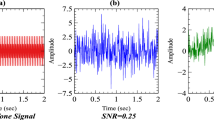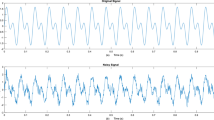Abstract
The vibration signal of the run-up or run-down process is more complex than that of the stationary process. A novel approach to fault diagnosis of roller bearing under run-up condition based on order tracking and Teager-Huang transform (THT) is presented. This method is based on order tracking, empirical mode decomposition (EMD) and Teager Kaiser energy operator (TKEO) technique. The nonstationary vibration signals are transformed from the time domain transient signal to angle domain stationary one using order tracking. EMD can adaptively decompose the vibration signal into a series of zero mean amplitude modulation-frequency modulation (AM-FM) intrinsic mode functions (IMFs). TKEO can track the instantaneous amplitude and instantaneous frequency of the AM-FM component at any instant. Experimental examples are conducted to evaluate the effectiveness of the proposed approach. The experimental results provide strong evidence that the performance of the Teager-Huang transform approach is better to that of the Hilbert-Huang transform approach for bearing fault detection and diagnosis. The Teager-Huang transform has better resolution than that of Hilbert-Huang transform. Teager-Huang transform can effectively diagnose the faults of the bearing, thus providing a viable processing tool for gearbox defect monitoring.
Similar content being viewed by others
References
L. Cohen, Time-frequency analysis, Prentice-Hall, Englewood Cliffs, NJ, 1995.
J. Lin and L. Qu, Feature extraction based on Morlet wavelet and its application for mechanical fault diagnosis, Journal of Sound and Vibration, 234(1) (2000) 135–148.
W. J. Staszewski, Wavelet based compression and feature selection for vibration analysis, Journal of Sound and Vibration, 211(5) (2000) 736–760.
C. James Li and Jun Ma, Wavelet decomposition of vibration for detection of bearing-localized defects, NDT&E International, 30(3) (1997) 143–149.
S. Prabhakar, A. R. Mohanty and A. S. Sekhar, Application of discrete wavelet transform for detection of ball bearing race fault, Tribology International, 3(12) (2002) 793–800.
W. J. Wang and P. D. Mcfadden, Application of orthogonal wavelet to early gear damage detection, Mechanical Systems and Signal Processing, 9(5) (1995) 497–507.
W. J. Staszewski, K. Worden and G. R. Tomlinson, Thefrequency analysis in gearbox fault detection using the Wigner-Ville distribution and pattern recognition, Mechanical Systems and Signal Processing, 11(5) (1997) 673–692.
L. Galleani and L. Cohen, The Wigner distribution for classical system, Physics Letters A, 302(4) (2002) 149–155.
G. Matz and F. Hlawatsch, Wigner distribution (nearly) everywhere: time-frequency analysis of signals, systems, random process, signal spaces, and frames, Signal Processing, 83(7) (2003) 1355–1378.
F. Hlawatsch and W. Kozek, The Wigner distribution of a linear signal space, IEEE transaction on signal processing, 41(3) (1993) 1248–1258.
N. E Huang, Z. Shen and S. R. Long et al, The empirical mode decomposition and the Hilbert spectrum for nonlinear and non-stationary time series analysis, Proceeding of Royal Society London, Series A, 454 (1998) 903–995.
H. Li, Y. Zhang and H. Zheng, Wear Detection in Gear System Using Hilbert-Huang Transform, Journal of Mechanical Science and Technology, 20(11) (2006) 1781–1789.
E. Lopatinskaia, J. Zhu and J. Mathew, Monitoring varying speed machinery vibration — I. The use of non-stationary recursive filters, Mechanical Systems and Signal Processing, 9(6) (1995) 635–645.
E. Lopatinskaia, J. Zhu and J. Mathew, Monitoring varying speed machinery vibration — II. Recursive filters and angle domain, Mechanical Systems and Signal Processing, 9(6) (1995) 647–655.
G. Meltzer and Y. Y. Ivanov, Fault detection in gear drives with non-stationary rotational speed — part I: the timefrequency approach, Mechanical Systems and Signal Processing, 17(5) (2003) 1033–1047.
G. Meltzer and Y. Y. Ivanov, Fault detection in gear drives with non-stationary rotational speed-part II: the timequefrency approach, Mechanical Systems and Signal Processing, 17(2) (2003) 273–283.
JianDa Wu, ChinWei Huang and Rongwen Huang, An application of a recursive kalman filtering algorithm in rotating machinery fault diagnosis, NDT&E International, 37(3) (2004) 411–419.
Zhinong Li, Zhaotong Wu, Yongyong He and Chu Fulei, Hidden Markov model-based fault diagnostics method in speed-up and speed-down process for rotating machinery, Mechanical Systems and Signal Processing, 19(2) (2005) 329–339.
R. Potter, A New Order Tracking Method for Rotating Machinery, Sound and Vibration, 7 (1990) 30–34.
R. Potter and M. Gribler, Computed Order Tracking Obsoletes Older Methods, Proceedings of the SAE Noise and Vibration conference, (1989) 63–67.
K. R. Fyfe and E. D. S. Munck, Analysis of computed order tracking, Mechanical Systems and Signal Processing, 11(2) (1997) 187–205.
K. M. Bossley and R. J. Mckendrick, Hybrid computed order tracking, Mechanical Systems and Signal Processing, 13(4) (1999) 627–641.
N. E. Huang, Z. Shen and S. R. Long, A new view of nonlinear water waves: The Hilbert spectrum, Annual Review of Fluid Mechanics, 31 (1999) 417–457.
J. Nunes, Y. Bouaoune, E. Delechelle, O. Niang and P. Bunel, Image analysis by bidimensional empirical mode decomposition, Image and Vision Computing, 21 (2003) 1019–1026.
S. Quek, P. Tua and Q. Wang, Detecting anomalies in beams and plate based on the Hilbert-Huang transform of real signals, Smart Materials and Structures, 12 (2003) 447–460.
S. J. Loutridis, Damage detection in gear system using empirical mode decomposition Engineering Structure, 26 (2004) 1833–1841.
H. Li, H. Zheng and L. Tang, Wigner-Ville Distribution Based on EMD for Faults Diagnosis of Bearing, Lecture Notes in Computer Science, 4223 (2006) 803–812.
P. Maragos, J. F. Kaiser and T. F. Quatieri, Energy separation in signal modulations with application to speech analysis, IEEE Transactions on Signal Processing, 41(10) (1993) 3024–3051.
P. Maragos, J. F. Kaiser and T. F. Quatieri, On amplitude and frequency demodulation using energy operators. IEEE Transactions on Signal Processing, 41(5) (1993) 1532–1550.
D. Vakman, On the analytic signal, the Teager-Kaiser energy algorithm, and other methods for defining amplitude and frequency, IEEE Transactions on Signal Processing, 44(4) (1996) 791–797.
A. Potamianos and P. Maragos, A comparison of the energy operator and the Hilbert transform approach to signal and speech demodulation, Signal Processing, 37(1) (1994) 95–120.
J. C. Cexus and A. O. Boudraa, Teager-Huang analysis applied to sonar target recognition, International Journal of Signal Processing, 1(1) (2004) 23–27.
J. C. Cexus and A. O. Boudraa, Nonstationary signals analysis by Teager-Huang Transform (THT), Proceedings of EUSIPCO, (2006) 1–5.
Author information
Authors and Affiliations
Corresponding author
Additional information
This paper was recommended for publication in revised form by Associate Editor Hong Hee Yoo
Hui Li received his B.S. in Mechanical Engineering from the Hebei Polytechnic University, Hebei, China, in 1991. He received his M.S. in Mechanical Engineering from the Harbin University of Science and Technology, Heilongjiang, China, in 1994. He received his Ph.D from the School of Mechanical Engineering of Tianjin University, Tianjin, China, in 2003. He was a postdoctoral researcher in Shijiazhuang Mechanical Engineering College from August 2003 to September 2005, and in Beijing Jiaotong University from March 2006 to December 2008. He is currently a professor in Mechanical Engineering at Shijiazhuang Institute of Railway Technology, China. His research and teaching interests include hybrid driven mechanism, kinematics and dynamics of machinery, mechatronics, CAD/CAPP, signal processing for machine health monitoring, diagnosis and prognosis. He is currently a senior member of the Chinese Society of Mechanical Engineering.
Rights and permissions
About this article
Cite this article
Li, H., Zhang, Y. & Zheng, H. Bearing fault detection and diagnosis based on order tracking and Teager-Huang transform. J Mech Sci Technol 24, 811–822 (2010). https://doi.org/10.1007/s12206-009-1211-9
Received:
Revised:
Accepted:
Published:
Issue Date:
DOI: https://doi.org/10.1007/s12206-009-1211-9




